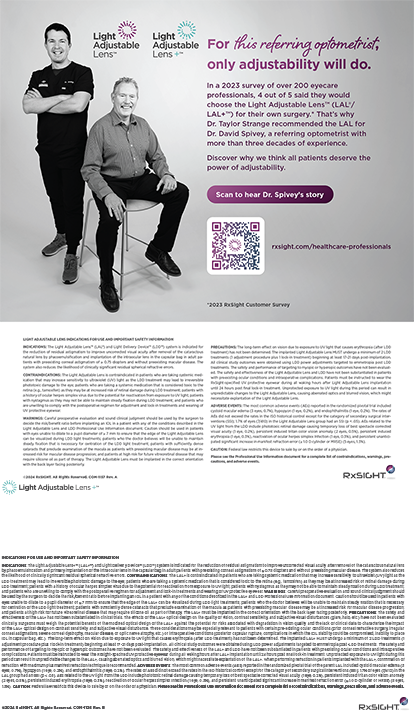There are two major benefits to performing endoscopic cyclophotocoagulation (ECP). First, it lowers IOP in a controlled fashion, which is arguably one of the safest ways to lower IOP in patients with glaucoma.1 It is well accepted that a sudden, drastic decrease in IOP, such as with drainage devices or trabeculectomy, can lead to choroidal effusions or hypotonous retinopathy and associated blurred vision. This outcome will disappoint patients, who have grown to expect excellent visual acuity with few postoperative complications after cataract surgery.
Second, ECP can be performed in combination with cataract surgery. The latter procedure does not have to be changed from the clinician's normal surgical protocol to accommodate ECP, whether he or she is performing laser cataract surgery, correcting astigmatism, or inserting a premium IOL. This article shares my surgical procedure and my pearls for combining ECP and cataract surgery.
SURGICAL COURSE
At the start of ECP from an anterior approach, I use Healon GV (Abbott Medical Optics Inc.) because I find that it does not leak out of the eye during surgical manipulation, and it is easily removed at the end of the procedure. The latter quality is important, because a common problem immediately after ECP is a spike in the patient's IOP, which is often caused by residual viscoelastic. After I instill the viscoelastic, I make an additional incision the size of the primary cataract incision, and I inflate the sulcus by 180º at a time. I make the second incision superonasally so that I have two sites through which to put the laser probe. My goal during ECP is to paint over the entire region of ciliary processes and expose it to laser energy. I do not target the processes one by one; instead, I paint over the entire region both on top of and between the processes. I make every effort not to ablate the back of the iris, because, in my experience, doing so causes inflammation and leaves an irregular pupil postoperatively. After I treat 180º to 240º of the ciliary processes, I remove the probe and inflate the sulcus on the opposite side of the eye. Then, I perform ablation through the second incision for a total treatment of 360º in an effort to lower IOP maximally. I am slow and steady in my use of the laser; this approach avoids popping of the ciliary processes, which can lead to inflammation. Prior to surgery, I enlarge small pupils with an expansion device so that I do not hit the iris with the ECP probe, which can also lead to inflammation or pigment dispersion.
I examine patients on postoperative day 1, and I prescribe brimonidine and acetozolamide to prevent IOP spikes. The postoperative pharmaceutical regimen is my usual for cataract surgery, including antibiotics, steroids, and nonsteroidal antiinflammatory drugs. When I see the patient again 1 week postoperatively, I instruct him or her to discontinue using all medications except the steroids, which the patient will administer for an additional week to a month.
SURGICAL PEARLS
Get Ahead of Inflammation
To prevent inflammation, I have the anesthesiologist administer intravenous dexamethasone. I also prescribe a potent topical steroid such as difluprednate 0.05% (Durezol; Alcon Laboratories, Inc.) postoperatively for the same purpose. Because inflammation is the biggest concern with ECP, my philosophy is to get ahead of the condition as much as possible. At the end of the procedure, I perform an intracameral injection of dexamethasone.
Implant the Lens After ECP
I perform ECP before implanting the IOL. The advantage to this approach is that I can see and access more of the ciliary processes. Performing ECP after the lens implant is in place is appealing, however, because it allows the ophthalmologist to complete one surgical procedure before moving to another.
Use Two Incisions
I insert the laser probe through two incisions to facilitate thorough treatment, and I use relatively low settings of 0.2 to 0.5 W. When passing the probe through two incisions, I can avoid torquing the cornea. In contrast, if I employ one incision, I may stretch the cornea at the end of the range of viewable ciliary processes, which can cause Descemet folds and corneal edema.
THE LEARNING CURVE
The learning curve for ECP is typical of any procedure in which the surgeon is looking at a monitor versus through the endoscope. Mastering the former setup takes a lot of practice. I recommend inserting the endoscope at the end of a regular cataract procedure just to get used to looking inside and manipulating the eye. It is also helpful to ensure the OR staff's comfort with the settings, the tilt of the endoscope, and the lighting inside the eye. Conducting a few dry runs is better than struggling through the real procedure when under pressure.
CONCLUSION
These surgical pearls can help make combined ECP and cataract surgery a low-maintenance procedure for the simultaneous treatment of glaucoma and cataracts. The impact on patients' refractive error and postoperative course is not much different than that of cataract surgery alone. The IOP lowering provided by ECP over the cataract surgery alone increases the chances of patients, either decreasing their medication load or having significantly lower IOP postoperatively.
Robert J. Noecker, MD, MBA, is in private practice at Ophthalmic Consultants of Connecticut in Fairfield, Connecticut. He is a consultant to Endo Optiks. Dr. Noecker may be reached at noeckerrj@gmail.com.
- Jung KI, Lim SA, Lopilly Park HY, Park CK. Risk factors for decompression retinopathy after glaucoma surgery [published online ahead of print February 19, 2013]. J Glaucoma. doi: 10.1097/IJG.0b013e318287aba0.


